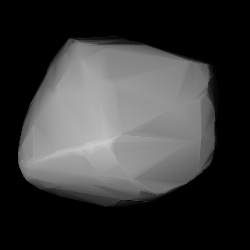Top Qs
Timeline
Chat
Perspective
1080 Orchis
From Wikipedia, the free encyclopedia
Remove ads
1080 Orchis, provisional designation 1927 QB, is a dark background asteroid from the inner regions of the asteroid belt. It was discovered on 30 August 1927, by German astronomer Karl Reinmuth at the Heidelberg Observatory in southwest Germany.[18] The carbonaceous F-type asteroid has a rotation period of 16.1 hours and measures approximately 22 kilometers (14 miles) in diameter. It was named after the flowering plant Orchis.[3]
Remove ads
Orbit and classification
Orchis is a non-family asteroid of the main belt's background population.[5] It orbits the Sun in the inner asteroid belt at a distance of 1.8–3.0 AU once every 3 years and 9 months (1,374 days; semi-major axis of 2.42 AU). Its orbit has an eccentricity of 0.26 and an inclination of 5° with respect to the ecliptic.[1] The asteroid was first observed as A906 BH at Heidelberg in January 1906. The body's observation arc begins with its official discovery observation in August 1927.[18]
Remove ads
Naming
This minor planet was named after the flowering plant Orchis, a genus in the orchid family. The official naming citation was mentioned in The Names of the Minor Planets by Paul Herget in 1955 (H 102).[3]
Reinmuth's flowers
Due to his many discoveries, Karl Reinmuth submitted a large list of 66 newly named asteroids in the early 1930s. The list covered his discoveries with numbers between (1009) and (1200). This list also contained a sequence of 28 asteroids, starting with 1054 Forsytia, that were all named after plants, in particular flowering plants (also see list of minor planets named after animals and plants).[19]
Remove ads
Physical characteristics
In the Tholen classification, Orchis is an uncommon F-type asteroid, a type which belongs to the wider C-complex of carbonaceous asteroids.[1][4]
Rotation period and poles
In 2010, three rotational lightcurves of Orchis were obtained from photometric observations. Lightcurve analysis gave a rotation period of 16.061, 16.075 and 16.1 hours with a brightness amplitude of between 0.23 and 0.31 magnitude (U=2+/2/3).[13][15][16] A modeled lightcurve based on optical data from a large collaboration network found a concurring period of 16.0657 hours and two spin axis of (255.0°, 27.0°) and (71.0°, 28.0°) in ecliptic coordinates (λ, β).[14]
Diameter and albedo
According to the surveys carried out by the Infrared Astronomical Satellite IRAS, the Japanese Akari satellite and the NEOWISE mission of NASA's Wide-field Infrared Survey Explorer, Orchis measures between 20.755 and 24.62 kilometers in diameter and its surface has an albedo between 0.029 and 0.051.[6][7][8][9][10][11][12] The Collaborative Asteroid Lightcurve Link adopts the results obtained by IRAS, that is, an albedo of 0.0430 and a diameter of 23.28 kilometers based on an absolute magnitude of 12.2.[4][10]
References
External links
Wikiwand - on
Seamless Wikipedia browsing. On steroids.
Remove ads

